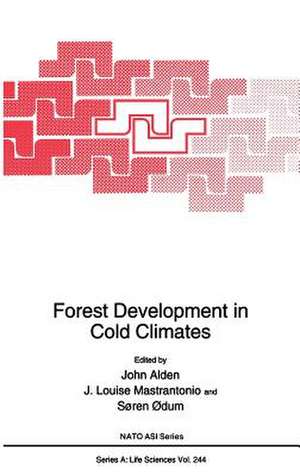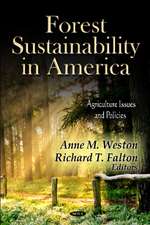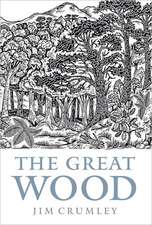Forest Development in Cold Climates: NATO Science Series A:, cartea 244
Editat de John Alden, J.Louise Mastrantonio, Soren Ødumen Limba Engleză Hardback – 30 iun 1993
| Toate formatele și edițiile | Preț | Express |
|---|---|---|
| Paperback (1) | 1230.35 lei 6-8 săpt. | |
| Springer Us – 11 iun 2013 | 1230.35 lei 6-8 săpt. | |
| Hardback (1) | 1236.82 lei 6-8 săpt. | |
| Springer Us – 30 iun 1993 | 1236.82 lei 6-8 săpt. |
Din seria NATO Science Series A:
- 15%
 Preț: 656.58 lei
Preț: 656.58 lei - 15%
 Preț: 655.13 lei
Preț: 655.13 lei - 15%
 Preț: 678.35 lei
Preț: 678.35 lei -
 Preț: 397.38 lei
Preț: 397.38 lei - 5%
 Preț: 377.87 lei
Preț: 377.87 lei -
 Preț: 397.76 lei
Preț: 397.76 lei - 18%
 Preț: 1232.41 lei
Preț: 1232.41 lei - 5%
 Preț: 731.64 lei
Preț: 731.64 lei -
 Preț: 413.15 lei
Preț: 413.15 lei - 15%
 Preț: 649.22 lei
Preț: 649.22 lei - 5%
 Preț: 369.45 lei
Preț: 369.45 lei -
 Preț: 407.56 lei
Preț: 407.56 lei - 5%
 Preț: 2162.19 lei
Preț: 2162.19 lei -
 Preț: 407.39 lei
Preț: 407.39 lei -
 Preț: 396.40 lei
Preț: 396.40 lei - 15%
 Preț: 663.93 lei
Preț: 663.93 lei -
 Preț: 387.38 lei
Preț: 387.38 lei -
 Preț: 393.13 lei
Preț: 393.13 lei -
 Preț: 398.35 lei
Preț: 398.35 lei -
 Preț: 401.24 lei
Preț: 401.24 lei - 15%
 Preț: 678.81 lei
Preț: 678.81 lei -
 Preț: 395.09 lei
Preț: 395.09 lei - 18%
 Preț: 952.40 lei
Preț: 952.40 lei - 15%
 Preț: 654.43 lei
Preț: 654.43 lei -
 Preț: 402.00 lei
Preț: 402.00 lei -
 Preț: 401.24 lei
Preț: 401.24 lei - 15%
 Preț: 655.27 lei
Preț: 655.27 lei -
 Preț: 394.71 lei
Preț: 394.71 lei -
 Preț: 384.48 lei
Preț: 384.48 lei - 5%
 Preț: 395.61 lei
Preț: 395.61 lei - 5%
 Preț: 1421.57 lei
Preț: 1421.57 lei - 15%
 Preț: 651.34 lei
Preț: 651.34 lei -
 Preț: 400.10 lei
Preț: 400.10 lei -
 Preț: 386.99 lei
Preț: 386.99 lei - 5%
 Preț: 386.11 lei
Preț: 386.11 lei -
 Preț: 403.91 lei
Preț: 403.91 lei - 15%
 Preț: 651.51 lei
Preț: 651.51 lei -
 Preț: 393.90 lei
Preț: 393.90 lei - 5%
 Preț: 376.43 lei
Preț: 376.43 lei -
 Preț: 400.26 lei
Preț: 400.26 lei - 5%
 Preț: 388.84 lei
Preț: 388.84 lei -
 Preț: 400.65 lei
Preț: 400.65 lei - 5%
 Preț: 740.58 lei
Preț: 740.58 lei - 18%
 Preț: 1225.16 lei
Preț: 1225.16 lei - 5%
 Preț: 386.46 lei
Preț: 386.46 lei -
 Preț: 421.82 lei
Preț: 421.82 lei
Preț: 1236.82 lei
Preț vechi: 1508.31 lei
-18% Nou
Puncte Express: 1855
Preț estimativ în valută:
236.70€ • 246.20$ • 195.41£
236.70€ • 246.20$ • 195.41£
Carte tipărită la comandă
Livrare economică 12-26 aprilie
Preluare comenzi: 021 569.72.76
Specificații
ISBN-13: 9780306444807
ISBN-10: 0306444801
Pagini: 570
Ilustrații: XIV, 570 p.
Dimensiuni: 156 x 234 x 32 mm
Greutate: 0.99 kg
Ediția:1993
Editura: Springer Us
Colecția Springer
Seria NATO Science Series A:
Locul publicării:New York, NY, United States
ISBN-10: 0306444801
Pagini: 570
Ilustrații: XIV, 570 p.
Dimensiuni: 156 x 234 x 32 mm
Greutate: 0.99 kg
Ediția:1993
Editura: Springer Us
Colecția Springer
Seria NATO Science Series A:
Locul publicării:New York, NY, United States
Public țintă
ResearchCuprins
Socioeconomic Importance of Forests in Iceland.- Biochemical and Physiological Requirements of Trees for Forest Development beyond Tree Limits.- Molecular Bases for Adaptation of Coniferous Trees to Cold Climates.- Growth and Development of Northern Forest Trees as Affected by Temperature and Light.- Testing Winter Desiccation Resistance for Species and Provenance Selection at Timberlines.- Growth of Mountain Birch (Betula Pubescens Ehrh.) in Response to Changing Temperature.- Performance of Mountain Birch in Different Environments in Sweden and Iceland: Implications for Afforestation.- Environmental Limitations of Forest Development at and beyond Tree Limits.- Causes of Alpine Timberline: A Review of the Hypotheses.- Physiology of Trees at Treeline.- Treeline in Relation to Climate, with Special Reference to Oceanic Areas.- Pliocene Fossil Nothofagus (Southern Beech) from Antarctica: Phytogeography, Dispersal Strategies, and Survival in High Latitude Glacial-Deglacial Environments.- Predicting Afforestation Success during Climatic Warming at the Northern Limit of Forests.- Climate Change as Seen by Trees and by Climate Modelers.- Effects of Wind on Boreal Forests.- Long-Term Biometeorological Monitoring at Two Forest Sites in Iceland and Newfoundland: Initial Results.- Potential Tree Species and Provenances for Forest Development in Cold Climates.- Genetic Diversity of Tree Populations at Their Arctic Limits.- Potential Species and Provenances for Forest Development in Cold Climates.- Species and Provenance Choice at Northern Tree Limits in Maritime Climates.- Seed Collections from North American Trees for Marginal Sites in the Nordic Countries.- The Uses of Lignoses in Horticulture in Iceland.- Provenance Selection, Testing, and Breeding to Accelerate Adaptation and Growth of Trees and Shrubs.- Accelerating Adaptation of Trees at Tree Limits by Selective Breeding.- Selection and Breeding of Scots Pine for Northern Sweden.- Provenance and Individual Variation in Climatic Hardiness of Scots Pine in Northern Finland.- Hybridization among Provenances of Lodgepole Pine.- Genetics, Cytogenetics, and Molecular Genetics of Icelandic Birch: Implications for Breeding and Reforestation.- Chloroplast DNA Diversity, Phylogenetics, and Hybridization in Picea.- Genetic Variation in Early Frost Tolerance of Spruce from Northwestern North America.- Case Histories of Forest Development beyond Tree Limits.- History of Tree Planting on the Aleutian Islands.- Afforestation of Lutz Spruce, Sitka Spruce, and Norway Spruce in the Vesteraalen Islands, Norway.- Development of an Environmental Forest and Arboretum on the Outer Coast of Finnmark County, Norway.- Forest Development in Iceland.- Potential Treeline in the Faroe Islands.- Forest Trials at High Elevations in Britain.- Wind and Wave Forests: A Case Study and Implications for Silviculture.- The Alpine Timberline of Tibet.- Forestry in New Zealand’s Southern High Country.- Summaries of Working Group Sessions.- Species Index.






